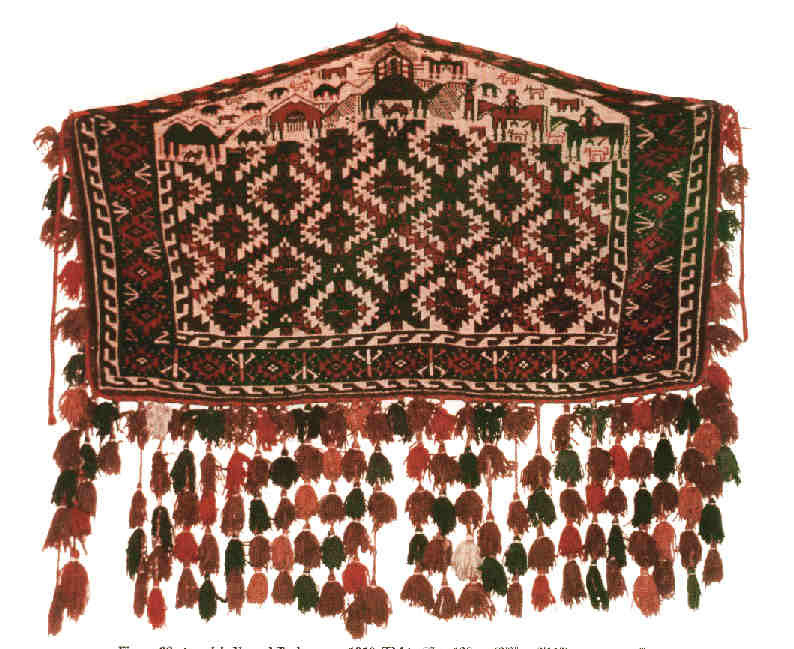Hi Steve
I think we have a common
resistance towards interpretations without reservations in this field
(perhaps I have learned it here on Turkotek) But perhaps I have an
additional reservation towards the opposite position, which often
concludes that almost nothing can be said.
So I will take the
liberty of saying a bit more, especially because seeing a possible
connection between the Asmalyk and the Kejebe design trickers my favorite
speculation.
When looking at the row of Camels and Asmalyks on the
Ensi it is not that I see a naturalistic depiction of a mass-wedding, on
the contrary I see the singularly totality of Kebeje tent, Camel and
Asmalyk taken out of its context and turned into a pattern of signs. This
process of transformation is perhaps also the background of the Kejebe
design in the top of the Ensi. Of course a much older and more complex
transformation than that of the naturalistic Camels. A transformation
probably with multiple sources which goes at least back to the Seljuks in
the 11th century. The Seljuk multiple niche prayer rugs surely are related
to the Kejebe design trappings. But then again what constituted the
singular Seljuk prayer niche? My own speculative open answer (which I know
in writing sounds absurd

) is a strange melting point between the
kufic alphabet (which is one of the multiple source of the Kejebe design)
and some kind of mobile ceremonial architectural structure which the
Turkmens brought with them on their journey to Anatolien. That mobile
structure could perhaps be very closely related to the Kejebe tent. Of
course totally speculations, but based on looking at the rugs.
Naturalistic figurations in the Turkmen weaving is of course the
exception, but turning signs into patterns certainly could be the
background rule rather than the exception. And Steve, I must say I think
you are too harsh on the Ramshorn

I find it a bit unfair when
you say you see them everywhere and therefore will not assign any meaning
to them. To put it up a bit argumentative: perhaps like going into a
Christian church seeing crosses everywhere, on the floor, on textiles, on
the alters, on the books, and then concluding they are everywhere and
meaningless. Of course some of the crosses may be purely decorative, some
may even be random, but certainly some of them are the very basis of the
church. Not sure if I will call this speculation because I suppose the
Ramshorn pattern is almost a kind of self-explanatory symbol: The Rams
fertility and potens in an nomadic sheep-based culture can hardly
overestimated, and the specific Turkmen version of the sign where it as
much looks like the first leaves of a small and fragile growing plant is
beautiful in its simplicity and depth.
Here is another Yomud
Asmalyk with naturalistic drawings of the Bridal ceremony, similar to the
one I posted earlier:

A thing that strikes me is, as you
also pointed out, that on both we have the Camel with the Kejebe but
without the Asmalyk, followed by a camel with an Asmalyk. Perhaps we here
have an explanation on why we have so many Yomud Asmalyks compared to
Asmalyks from the other tribes: Perhaps the Yomuds at a point started
dressing more than one camel in bridal caravan up with Asmalyks? The
Kejebe were simplified as a sign and transformed to the Asmalyk, perhaps
in an attempt on multiplying good luck and fertility - and thereby
multiplied the number of Yomud Asmalyks that still goes around today. As
always: only speculation of course

best Martin